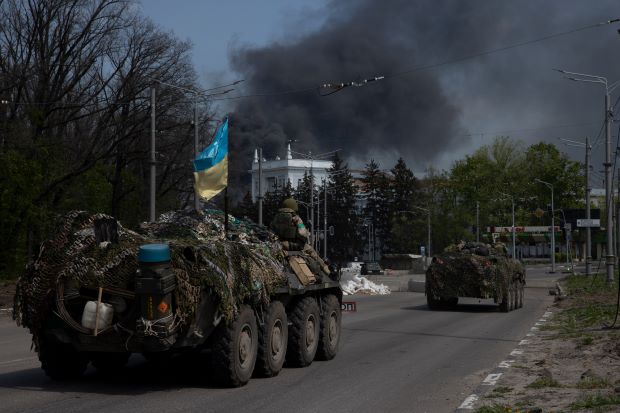Russian forces assault the Mariupol steel plant
By Marc Santora
KYIV – Russian forces mounted a furious assault on the Azovstal steel factory Thursday (5) after breaching Ukrainian perimeter defences, seeking to destroy the last pocket of resistance in the ruined city of Mariupol and allow Moscow to claim a victory before a symbolically important Russian holiday.
“It has been two days since the enemy broke into the territory of the plant,” Lt. Col. Denys Prokopenko, a Ukrainian commander, said in a video posted overnight. “Heavy, bloody battles are raging.”
A few hours later, Petro Andriushchenko, an adviser to the city government, said that there had been nonstop shelling overnight and into the morning. The last patch of Ukrainian resistance beneath the hulking remains of what had once been one of Europe’s largest steel plants has been “turned into hell,” he said.
Ukrainian fighters have successfully defended the plant from a direct assault for weeks. But Russian forces managed to find their way into the 4-square-mile complex with the help of a former worker familiar with its layout, according to Anton Gerashchenko, an adviser to the Ministry of Internal Affairs.
Gerashchenko, on social media and speaking to reporters, said that an electrician who worked at Azovstal showed the Russians the tunnels they could use to enter the complex. He tied the assault to a Russian desire to declare “victory” in Mariupol before the Monday (9) holiday commemorating the Soviet Union’s triumph over Nazi Germany.
He said that is why the Kremlin recently dispatched Vladimir Solovyov, a national television host under sanctions by the West for his role in pushing Russian propaganda, to Mariupol.
In a sign of the city’s importance to Moscow, Russia is estimated by Western military analysts to have committed 12 to 14 battalions of around 1,000 soldiers each to the fight for Mariupol, roughly 10% of all its combat forces in Ukraine.
A senior Pentagon official said Wednesday (4) that only around two battalions remained, along with some units of Chechen fighters. The rest have been dispatched to the eastern front to be redeployed.
The decision to storm the factory could still prove costly — something President Vladimir Putin seemed to recognize when he ordered troops April 21 to hold back from a full-on assault. Fighting inside tunnels creates challenges even for a technologically superior conventional force such as Russia’s and could result in more casualties for Moscow’s troops, military experts say.
Ukrainian defenders in the city have exceeded the expectations of many outside observers — surviving despite being outnumbered, outgunned and cut off from resupply.
The city has been bombarded, leaving people desperate for food, many civilians dead and hundreds of buildings razed. When the city’s defences were breached, battles raged in the streets for weeks. With their numbers dwindling, an estimated 2,000 Ukrainian soldiers fell back to the plant.
It is unclear how many soldiers are still inside the complex. The Ukrainian government estimates that there are some 200 civilians still inside, including about 30 children.
The Russian government said that it would open humanitarian corridors in Mariupol to facilitate evacuations, but it was unclear how people in the steel factory could find a path to safety. Several hundred people have managed to evacuate in recent days.
Communications from the facility briefly went dark Wednesday, but Thursday morning, fighters in the bunkers were again sending messages via social media platforms, promising not to give up.
“The situation is extremely challenging but, nevertheless, we continue to keep the defence,” Prokopenko said.
-New York Times


